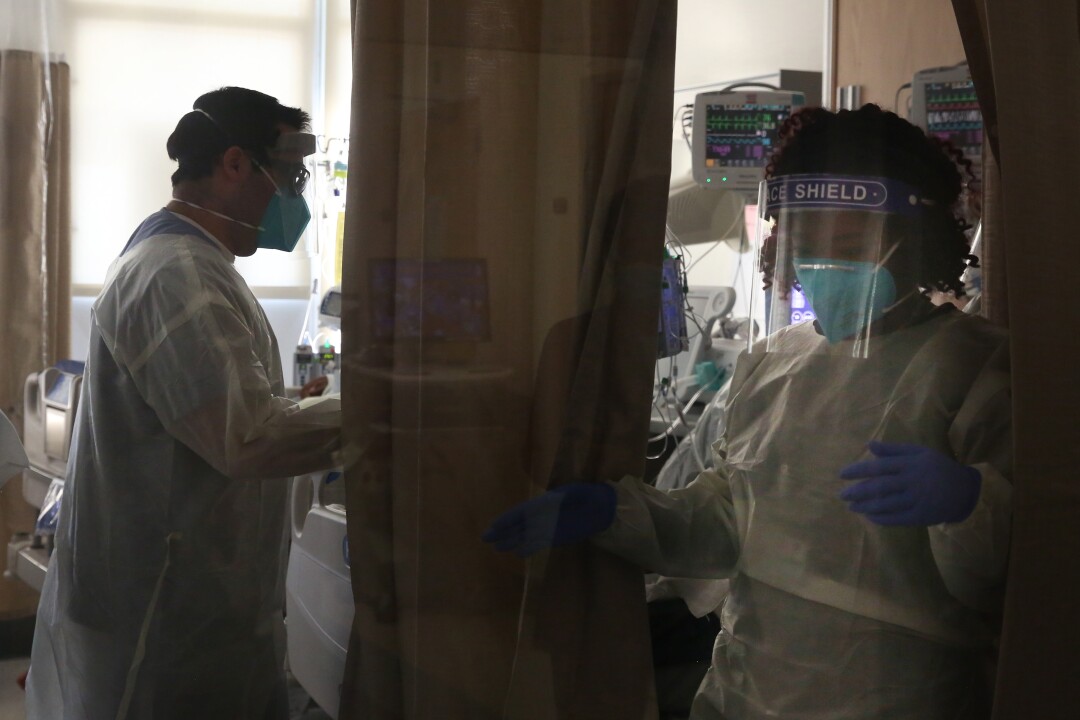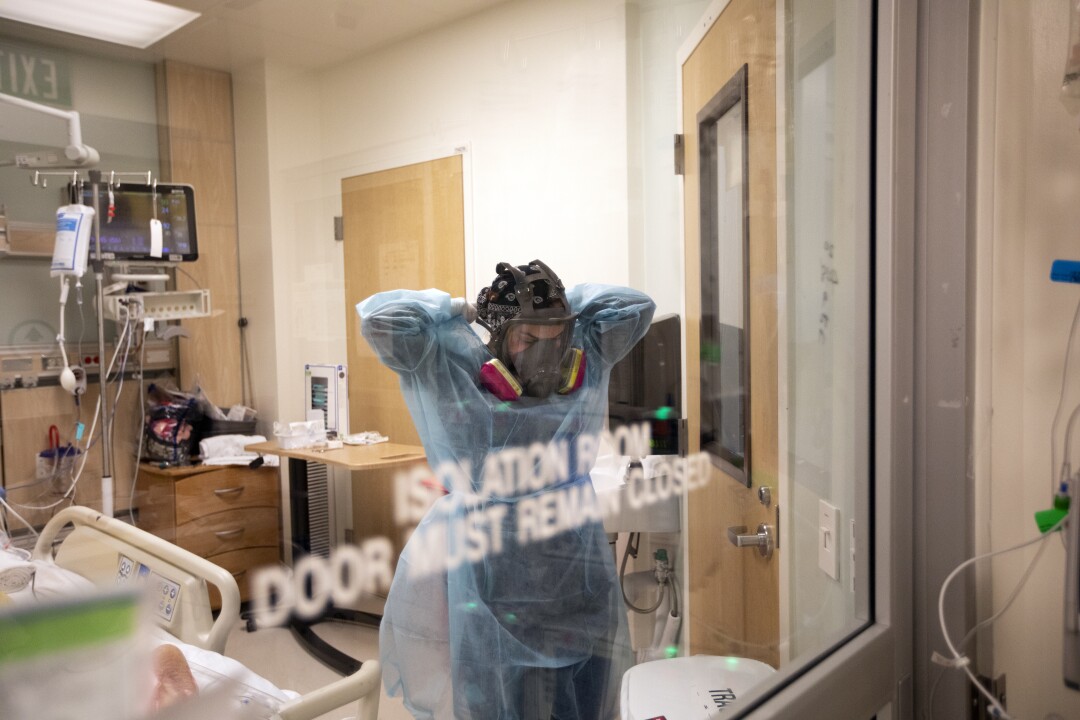[ad_1]
Many Californians spent New Year’s Eve in a safe place with immediate family. Dr. Nick Kwan, the assistant medical director of emergency services at Alhambra Hospital in Los Angeles County, spent it with a COVID-19 patient who went into code blue — cardiac or respiratory arrest — five separate times.
Code blue requires the medical staff to summon a quick and intense response to resuscitate the patient.
“It’s mentally, physically and emotionally draining,” said Kwan, who struggled to articulate the toll that a monthlong surge of COVID-19 patients is placing on his and other hospitals across Los Angeles County.
“This is a full-on Category 10. … It’s literally World War III,” he said.

Hospital doctors and nurses treat COVID-19 patients in a makeshift ICU wing this week at Harbor-UCLA Medical Center in West Carson. The hospital has no open beds for incoming patients and has worked tirelessly to create additional beds for the influx of coronavirus patients.
(Dania Maxwell / Los Angeles Times)
“It’s not the volume of patients,” he said. “It’s the intensity and sickness of the patients. I’ve never thought some of these numbers are compatible with life, with patients coming in sicker than you can imagine.”
Across L.A. County and much of Southern California, hospitals are struggling with an influx of intensely sick COVID-19 patients and a lack of resources, including staff and vital infrastructure, such as oxygen piping.
On Friday, the state summoned the U.S. Army Corps to help six hospitals dealing with severe challenges supplying oxygen to patients who needed it.
Alhambra Hospital was not among those, but it nonetheless was stretched thin by COVID-19 and the emotional toll it placed on all involved.
“I don’t think a lot of people outside are seeing what we are seeing,” Kwan said. “It’s hard until you are in there, until your family and loved ones are in there.”
Since Thanksgiving, the 144-bed hospital that serves as a melting pot of the San Gabriel Valley, many of whose residents are first- and second-generation Latino and Asian immigrants, has seen a steady wave of patients with difficulty breathing.
Kwan said that besides Alhambra, he knows several other hospitals along the 210 Freeway corridor are full and straining under the burdens of the present surge.
The waiting room at Alhambra Hospital is now a COVID ward. Regular beds have been quickly converted to ICU beds. And ambulances wait outside with arriving patients because “physically we can’t accommodate the patient” at that time, Kwan said. “It’s across the board. The virus doesn’t care who you are. You can be sick, healthy, young, old.”
Younger patients have died, and a patient in her 90s walked out of the hospital with an oxygen tank.
“It’s so unpredictable with each case,” he added.

Registered nurse Armela Masihi removes her isolation gown as she walks out of a COVID-19 patient’s room in the ICU at Martin Luther King Jr. Community Hospital.
(Francine Orr / Los Angeles Times)
“On the 29th and 30th of November, we started seeing the surge, and it’s been nonstop since then,” Kwan said. “It’s easy to say it is holiday gatherings — or maybe the colder weather. … Christmas and New Year’s scares me, and I think the worst is yet to come.”
A nurse sponsored by the state recently arrived to help combat the patient load, and it was a necessary boost to morale, Kwan said. Still, staff fear the deluge of December is a harbinger of a long, deadly winter.
“For the next month, I don’t see the end. It will keep piling up, and we have got to be ready.”
It was a similar picture in Santa Clara County, where hospitals remained stretched to the limit, with 50 to 60 patients stuck in emergency rooms each day waiting for a hospital bed.
Often, the only way a patient can be moved into an ICU bed is because a COVID-19 patient has died, according to Dr. Marco Randazzo, an emergency room physician at O’Connor Hospital in San Jose and St. Louise Regional Hospital in Gilroy.
“This has been the state of the pandemic for the last several weeks, and it is showing no signs of letting up,” said Dr. Ahmad Kamal, director of health preparedness for Santa Clara County. The daily coronavirus case rate there is more than 10 times as much as it was on Oct. 30. “What we are seeing now is not normal.”
At Alhambra Hospital, the virus struck staff directly: One emergency room physician at the hospital died of COVID-19, and a nurse who contracted the virus was out for months, Kwan said.
“Everyone is exhausted. Our CEO is exhausted. Our entire medical staff is exhausted,” Kwan said.
Kwan and other staffers have had to become accustomed to being the last person a patient sees before dying, with families kept away from loved ones.

Chaplain Anne Dauchy, left, places her hand on Dr. Marwa Kilani to comfort her. Kilani cries after talking to a patient’s family while standing inside the ICU on Thursday at Providence Holy Cross Medical Center in Mission Hills, Calif. Three people passed away from COVID complications in the morning along this hallway.
(Francine Orr / Los Angeles Times)
“You cry with the patients’ family. It’s just sad,” he said. “I feel like this virus attacks all our humanity.”
Behind the fatigue and strain on resources is the sheer fact that COVID-19 patients stay longer in the hospital than the average patient and require more resources.
There are ongoing concerns about whether there will be sufficient ventilators, and oxygen tanks have occasionally run low. But a major concern is simply space: “It doesn’t matter if it is Cedars, USC or Alhambra — the hospital is only so big.”
Morgue space, he said, is also finite — and an ongoing worry.
“When is the last time I thought we are going to run out of morgue space? I never thought this would be a concern of mine.”
Many patients coming in for routine ailments — such as family members who brought their baby to the ER on New Year’s Eve — are treated in the parking lot, sometimes even in their vehicles.
Kwan said he knows the toll that the pandemic is taking: businesses closing, family and friends limiting social gatherings. He hasn’t seen his mom since February and his dad since March. His children waited until five days after Christmas to open gifts and celebrate with their father.
“I would tell people out there that this is serious. Help us fight this war,” he said. “It’s a group effort — we cannot fix this by ourselves. It’s really on public awareness and a collective effort to conquer this.”
Kamal, the physician in Santa Clara County, pleaded with the public to not give up with wearing masks, staying socially distant and canceling gatherings. There are indications in the Bay Area and elsewhere those measures have helped stem the spread.
“We know,” he said, “that our decisions and our actions drive the curve of this pandemic.”

Chaplain Kevin Deegan, right, kneels as registered nurse Cristina Marco leans in to listen to Domingo Benitez, 70, inside the COVID unit at Providence Holy Cross Medical Center.
(Francine Orr / Los Angeles Times)
[ad_2]
Source link